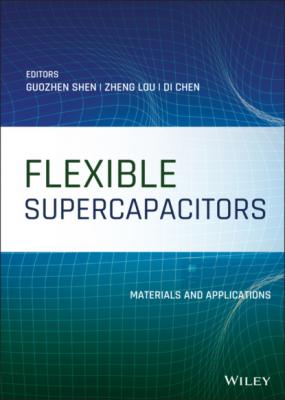Flexible Supercapacitors. Группа авторов
Чтение книги онлайн.
Читать онлайн книгу Flexible Supercapacitors - Группа авторов страница 11
 q+ = q−. The charge stored by each electrode depends on the specific capacitance (C), the potential range for the charge/discharge process (E) and the mass of the active electrode material (m), following the Eq. (1.3):
q+ = q−. The charge stored by each electrode depends on the specific capacitance (C), the potential range for the charge/discharge process (E) and the mass of the active electrode material (m), following the Eq. (1.3):
In order to get q+ = q− at the typical current density, the mass balancing will follow the Eq. (1.4):
In this way, the suitable mass ratio between the positive electrode (m+) and negative electrode (m−) is defined, which is much closed to the mass loading of the active materials of positive and negative electrode in typical AFSCs.
1.3 Progress of Flexible AFSCs
1.3.1 Sandwich‐Type AFSCs
To date, the most widely applied configuration of AFSCs is sandwich‐type AFSCs, which stacks two flexible flat electrodes face‐to‐face with an ionic conductive separator and liquid/gel electrolyte in the middle of the two electrodes to isolate direct contact. AFSCs with such shape holds great potential in future applications in flexible planar electronic devices, such as flexible display, wristbands, membrane‐type sensors, etc. [24]
1.3.1.1 Carbon‐Based Anodes
The most reliable anode materials for sandwich‐type AFSCs are carbon‐based materials with significant excellence in conductivity and mechanical stability, such as graphene, CNTs, carbon fibers, etc. [24, 25, 27, 56,95–97] For example, Zhai et al. [98] successfully synthesized hydrogenated MnO2 nanorods (H‐MnO2) on carbon cloth (CC) via electrodeposition followed by annealing in hydrogen atmosphere (Figure 1.3a), and loaded reduced graphene oxide (RGO) on CC using vacuum process. The obtained H‐MnO2 cathode and RGO anode were assembled as flexible solid‐state AFSC with LiCl/PVA gel electrolyte and a separator sandwiched in between. The as‐fabricated sandwich‐type AFSC (denoted as H‐MnO2//RGO) exhibited a reliable operating voltage window as wide as 1.8 V and extraordinary mechanical tolerance to bending (Figure 1.3b). Owing to the significantly wide potential window, the device achieved a high energy density of 0.25 mWh cm−3 at power density of 1.01 W cm−3, which has surpassed many SFSCs and some AFSCs previously reported. To verify the feasibility of the AFSCs device as energy storage device for wearable electronics, two H‐MnO2//RGO devices were tailored on a laboratory coat in series and able to power an electronic watch (Figure 1.3c). Recently, Yu and his co‐workers [25] reported a sandwich‐type AFSC with CNT‐textile anode and MnO2/graphene‐textile cathode, which achieved an operating potential window of 1.5 V and a maximum energy density of 12.5 W h kg−1. Choi et al. [56] developed a solid‐state AFSC based on an ionic liquid functionalized chemically modified graphene (IL‐CMG) film as anode and a hydrous RuO2‐ILCMG composite film as cathode, which reached a high output voltage of 1.8 V and thus delivered a maximum energy density of 19.7 W h kg−1 and maximum power density of 6.8 kW kg−1. Moreover, the as‐fabricated device exhibited superior cyclic stability even when bent or twisted.
Figure 1.3 (a) Schematic diagram illustrates the growth process for preparing H‐MnO2 NRs on carbon cloth substrate. (b) CV curves obtained at different bent conditions at 200 mV s−1. Insets are the photos of ASCs device on finger. (c) Schematic diagram and photo images of wearable ACS in real applications (sewing on the clothes model and powering electronic watch).
Source: Reproduced with permission [98]. © 2014, Elsevier Publishing.
Unfortunately, most carbon‐based anodes are relatively low in capacitance due to the electrochemical double layer energy storage mechanism. To this end, effective strategies of achieving high‐energy‐dense AFSCs has been extensively developed by employing pseudocapacitive anodes such as functionalized carbon, transition metal oxides, transition metal nitrides, conductive polymers, etc. [90] Recently, Wang et al. [90] creatively applied electrochemical activation to CC (Figure 1.4a), which were rarely employed as SC electrode materials because of its intrinsic low capacitance as a result of the small surface area and poor electrochemical activity [32]. The obtained electrochemically activated carbon cloth (EACC) anode was coupled with MnO2@TiN loaded on CC as cathode to fabricate a novel sandwich‐type AFSC (denoted as MnO2@TiN//EACC) with an extended operation voltage window of 2 V (Figure 1.4b). Besides the broadened voltage window, the impressively boosted capacitance of EACC due to the roughened surface and the introduction of oxygen‐containing groups on the surface for redox reactions also contribute to an excellent energy density as high as 1.5 mWh cm−3, which enables its successful application in powering light emitting diode (LED) indicator even under bent condition (Figure 1.4c).
1.3.1.2 Transition Metal Oxide Anodes
Transition metal oxides can generate reversible redox reactions on the surface or even in the bulk during charging/discharging, which results in much higher capacitances compared to carbon‐based anodes. By integrating transition metal oxides with flexible current collectors as pseudocapacitive anodes, the energy density of AFSC can be drastically enhanced. For example, Yang et al. [54] grew α‐MnO2 nanowires (NWs) and amorphous Fe2O3 nanotubes (NTs) on flexible carbon textile as the pseudocapacitive cathode and anode respectively (Figure 1.5a) to fabricate a sandwich‐type flexible asymmetric pseudocapacitor (Figure 1.5b). The as‐fabricated sandwich‐type AFSC operates at a maximum cell voltage of 1.6 V (Figure 1.5c) and delivers high energy density of 0.55 mWh cm−3 (Figure 1.5d). Two devices connected in series can readily operate a blue LED after charging (Figure 1.5d inset), indicating the potential of the AFSC in future applications. Similarly, a novel flexible all‐solid‐state asymmetric SC fabricated with a carbon‐fabric‐loaded WO3–x/MoO3–x core/shell nanowires anode and a polyaniline cathode was reported